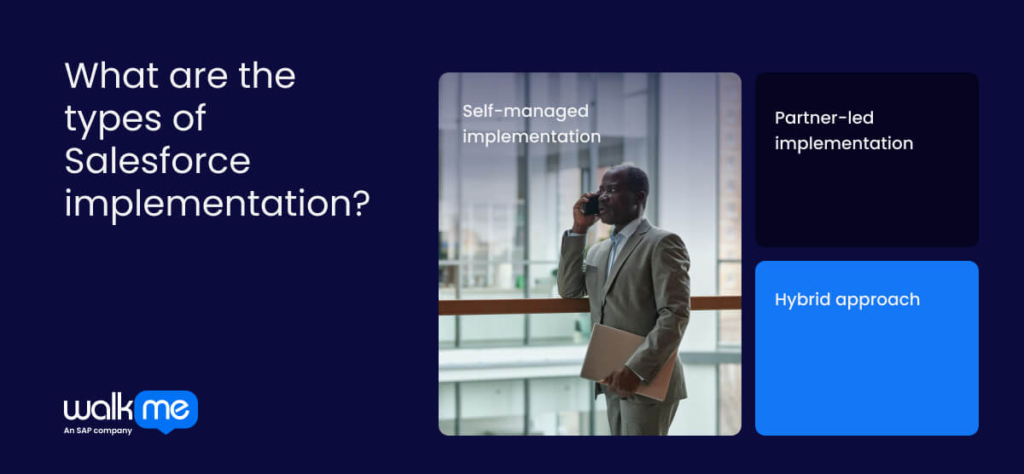A Salesforce CRM tool offers a single platform for making customer care a focal point of your business. However, setting up this tool requires careful planning, technical skills, and a clear business strategy.
If the technology feels complicated or time-consuming, employees may avoid using it. This leads to outdated data and poor digital adoption. To succeed, businesses must take a structured approach to Salesforce implementation.
When used correctly, Salesforce helps companies stay agile and respond to market changes. This guide explains implementation types, key steps, and best practices to ensure a smooth rollout.
What is Salesforce implementation?
Salesforce implementation is a structured method of rolling out the Salesforce CRM tool to serve a company’s requirements. If used successfully, it can lead to a better customer experience and employee retention as well as improve ROI.
What are the types of Salesforce implementation?

Salesforce implementation can take different approaches depending on your business needs, resources, and expertise. The main types include:
Self-managed implementation
A self-managed Salesforce implementation means the company handles the setup and deployment with minimal help from external consultants. The internal team manages the entire process using their expertise and resources.
But, managing the process can take a lot of time, especially for non-technical users. The lack of expert guidance may lead to errors or missing important features. Managing complex change and ensuring users adopt the system can be difficult without extra support.
Partner-led implementation
In a partner-led Salesforce implementation, the business works with a Salesforce consulting partner to organize the setup and integration of the Salesforce CRM system. The company relies on the partner’s knowledge to tailor the solution to its specific goals and ensure a successful deployment. In this scenario, the partner, rather than the business, implements Salesforce.
Hybrid approach
If you can handle some parts of Salesforce implementation yourself, a hybrid approach might work well. For instance, you may hire an implementation partner for planning, building, and training. But, you may already have an experienced team of developers to handle data cleansing and migration.
This approach is cheaper and more flexible since you only outsource the areas where you need help. However, it requires extra effort. Deciding which tasks to outsource and which to manage internally can be tricky.
Steps for a more efficient Salesforce implementation

A well-structured Salesforce implementation ensures smoother adoption and long-term success. Follow these six key steps to streamline the process:
Step 1: Define stakeholders and business goals
Before starting Salesforce implementation, businesses should assess whether Salesforce CRM aligns with their goals and identify what they want to achieve. They should also consider the challenges their teams and users face and time-consuming tasks that can be simplified.
Analyzing workflow inefficiencies and communication issues is crucial. Businesses should prioritize configuring essential features first. It’s also important to consider and involve the main stakeholders early in the process. These individuals include a decision-maker, project manager, team leads, and end-users to ensure better execution.
Step 2: Gather and prioritize requirements
Before defining system functions, gather stakeholder input on what they should look like. Use precise language and brief descriptions, and ensure each requirement is testable.
Ask individuals or teams to list requirements for the required system. Then, review them together. Since resources are limited, assign priorities: must-have for essential features, should-have for helpful but non-critical ones, and nice-to-have for added convenience.
Work with the Salesforce team to estimate effort and group requirements into modules. Clearly outline what each requirement includes and excludes. Adjust priorities based on budget constraints to ensure an efficient Salesforce implementation process.
Step 3: Customize and configure Salesforce
After setting goals and requirements, configure Salesforce to match these elements. Enter company details and create user profiles and roles that align with the organizational structure. This setup ensures each team member accesses the right data and tools.
Adjust objects, fields, and page layouts to create a simple user interface. A clear layout helps teams navigate the system easily. Once the basic setup is complete, customize features only when necessary. Modify homepages and layouts to meet business needs but avoid unnecessary changes. Keeping the system simple prevents complexity and reduces maintenance challenges as the business grows.
Step 4: Test system functionality before deployment
Before launching a Salesforce implementation, define a clear testing plan with test cases, environments, a schedule, and assigned testers.
Set up a sandbox environment to test configurations without risking real data. Verify each function to ensure proper data entry, validation, and output. Check system integrations to confirm smooth data flow between Salesforce and external tools.
After making changes, run regression tests to confirm all features still work correctly. Involve users in testing to ensure the system meets their needs. Next, performance should be evaluated under different conditions to confirm it can handle expected workloads.
Step 5: Train users and prepare for go-live
With the technical setup complete, focus on making the transition smooth for everyone.
Inform users early about upcoming changes. Share the expected transition date and send multiple reminders as the date approaches. Explain which systems will be replaced and how workflows will change.
Employee training plays a key role in user success. Train system managers on admin tasks. Guide general staff through in-person training a few days before implementation. Record all sessions to support both new and existing users. You can also adopt a digital adoption platform for personalized employee onboarding and ongoing self-help.
Step 6: Go live and monitor adoption
The go-live phase brings together all planning and hard work. To ensure a smooth launch, finalize data migration, set up user access, and monitor the system closely. Communicate clearly with all stakeholders about what to expect on launch day to prevent confusion.
Create a backup plan to handle issues like slow performance or data errors. Maintain and update Salesforce regularly to keep it aligned with business needs. Work with your implementation partner to establish long-term support. Review workflows frequently and collect user feedback. Then, use these insights to improve the system as your business evolves.
Best practices for a successful Salesforce implementation
Beyond the core implementation steps, following these best practices can help maximize Salesforce’s effectiveness and ensure long-term success:
Define success metrics aligned with business impact
Focus on key areas such as revenue growth, user adoption, return on investment (ROI), and customer lifetime value (CLV) to define success metrics for a Salesforce implementation.
Make sure these metrics align with your business goals. Set clear, measurable targets for each metric. This will help track progress and highlight areas that need improvement. Regularly monitor the data to identify trends. Adjust your Salesforce usage based on the findings. By staying proactive, you can ensure your implementation meets its objectives.
Implement a phased rollout strategy
A phased rollout has several benefits. It reduces risk by allowing you to spot and fix issues before a full deployment. It also improves user adoption, as involving users early helps them understand and accept the system. The gradual approach minimizes disruptions to workflows, making change management more efficient.
Start the Salesforce rollout with a small group of users or departments. Focus on key features for the first phase and add more advanced ones later. Clean and prepare data for the pilot group. Offer training and support. Gather feedback and adjust the system and training before moving to the next phase.
Focus on user adoption through continuous training
To improve user adoption of Salesforce tools during implementation, tailor the training to each user’s role and needs. Customize training for roles like sales reps, account managers, and marketing teams, focusing on relevant features. Use real-world exercises to help users practice.
For instance, offer quick guides and mini-courses within Salesforce to easily access answers or refreshers. Schedule regular training sessions to review key concepts and introduce new features. Build a rewards program that awards points, badges, and challenges to motivate users. Collect feedback often to improve training and address concerns.
Maintain high-quality CRM data
Accurate data improves lead qualification, targeted marketing, and personalized customer interactions. In addition, clean data saves time and boosts employee productivity.
To maintain high-quality CRM data in Salesforce, create a solid data management plan with clear rules for formatting, field usage, and acceptable values. Appoint data stewards to ensure data quality and enforce guidelines within teams.
Track key data quality metrics like completeness, accuracy, and consistency. Regularly audit the data to find errors, duplicates, and outdated information. Set up routine data cleansing to remove incorrect data. Use data enrichment tools to update customer info with verified data from external sources.
Work with certified Salesforce partners for scalability
Collaborate with the partner to design a flexible, modular system that can grow with your business. Roll out Salesforce in phases, starting with core features and adding more as you scale.
When choosing a Salesforce partner, check their Salesforce accreditation and certifications to ensure they have experience with your type of implementation. Define your growth plan, including expected user increases, data, and process complexity. Choose a partner skilled in using Salesforce features like custom objects, workflows, custom fields, and reporting.
Boost ROI and customer experience through a structured Salesforce implementation
Salesforce helps companies keep customer data in one place. This allows them sell more, manage data better, and work together easily. It’s flexible and helps businesses grow. To get the most from Salesforce, you need to plan well before you start using it.
First, pick how you want to set it up: by yourself, with help, or a mix of both. Next, know what you want to achieve. Choose the people who will use it, decide what you need it to do, and test it before everyone starts using it. Teach your staff how to use it. Also, plan how to check it works well after it’s set up. Pick the right ways to measure success and keep your customer data clean.
FAQs
A Salesforce implementation can take a few weeks for a simple setup to several months for more complex projects. For small to medium businesses, the average time is about 3 to 6 months.
Salesforce implementation is the process of setting up a company’s Salesforce CRM platform. This includes tasks like data migration, customizing features, and defining user roles. It also involves training employees and launching the system to manage customer relationships across departments.

